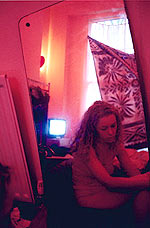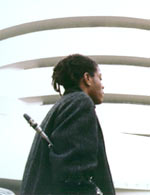Welcome To My Beautiful, Fucked Up Life | |

| When Bill Clinton decided to have a go at the fashion industry for promoting heroin chic, the journalists filling in the details of the Elvis President's scattershot attack named Corinne Day as one of the guilty parties. The primary offending item was a Kate Moss spread Day had shot for Vogue. Like most people, I reasoned that nobody was going to take drugs because of something they saw in Vogue - and if they did, they weren't worth worrying about. In any case, the world moved swiftly on to some other spurious scandal, and I didn't think about it again until I saw Corinne Day Diary (sic) at The Photographers Gallery in London. Rather than the pictures of Kate Moss or Moby that earn Day her crust, the pictures in the exhibition - as the title suggests - are her personal snaps, a memoir of a mainly London life in the '90s. They're very much in the casual yet somehow artful style pioneered in the '70s by Nan Goldin - in fact, if anyone missed the connection, the gallery's bookshop made it easy by displaying stacks of the catalogue next to a Goldin book. In the photos we see Day and her unnaturally beautiful set of friends - generally in some state of undress - lying on dirty beds, getting up in the morning, having messy parties in her flat, fooling around, in hospital (Day had an operation to remove a brain tumour), doing ketamine, smoking grass and taking smack. And as with the enjoyable Goldin-inspired movie High Art, you come away with the feeling that you are actually being sold heroin as part of a broader lifestyle choice. It's the combination of the gorgeousness of the subjects with their appealing slobby appearance that makes it all somehow more seductive than something like Friends. Now, the beauty plus heroin connection is hardly new. Elsewhere I've argued that in the movies, star junkies are always beautiful. But it would be easy let yourself get carried away with the idea that real junkies are equally photogenic: think of Chet Baker, River Phoenix, Nico, Gram Parsons, Kurt Cobain or Jean Michel Basquiat. From there, it is a short stop to a frenzied Romantic belief that that opiates exist because extreme Beauty must be allowed to destroy itself (roughly the thesis of Julian Temple's forthcoming film Pandemonium, a barmy Ken Russellesque tale about Coleridge and Wordsworth). Bullshit, of course: without straying from pop mythology, the figure of Nancy Spungeon is always there to remind us that smack addicts are often both stupid and ugly. Nevertheless, one of the reasons that some people - most notably corpulent Australian cultural guru Robert Hughes - refuse to take Jean Michel Basquiat seriously is because his looks and habits fit a cliche too easily. In the end, they complained, he was merely a Hollywood version of a doomed artist. And the recently disinterred film Downtown 81 only emphasises how ridiculously well cast he was in his own life. |

| It's a curious movie. Originally titled New York Beat, and conceived by journalist/man about downtown Glenn O'Brien, it consists mainly of a pre-fame Basquiat (then most notorious as gnomic graf artist SAMO) tramping the devastated streets of the Lower East Side. The parts of the soundtrack were lost, so the dialogue was all dubbed when the footage was rediscovered in 1999, and the narration that holds the thing together - more or less - is supplied by poet/actor Saul Williams, effectively playing Basquiat's interior monologue. So we have Basquiat's presence, but not his voice. Nevertheless, he looks more like a film star than any painter has a right to. There are two attempted plot strands: one has Jean searching for a European model he has met the on the street, the other has him trying to find his band's stolen equipment. Neither amounts to much, but that suits posterity. Downtown 81's incompetence as a piece of narrative fiction - most of the 'characters' go by their real names - is what makes a useful document of the time. If any of this is sounds kind of familiar, that might be because Downtown 81 has a lot in common with the 1983 graffiti drama Wild Style, which resurfaced on video a couple of years back. The films are linked by both style and personnel. Fab 5 Freddy, Lee Quinones and various members of Blondie crop up in both. There are two main differences: Quinones, the star of Wild Style, is ugly, badly dressed and uncharismatic - the un-Basquiat. And while the 'action' in Wild Style is interspersed with performances from early hip hop acts (Cold Crush, Grandmaster Flash), Downtown 81 art rocks to DNA, some Japanese new wavers called The Plastics, James White And The Blacks and Kid Creole And The Coconuts. Downtown 81 clearly isn't much of a feature film, but it does have a great sense of time and place, of the openness of New York at the start of the 80s. A time when Glenn Branca and Madonna moved in the same orbit, when postpunk rock and jazz and funk and the nascent hip hop scene rubbed together in interesting ways (something we were reminded of by that ESG compilation), and when the art scene and the music scene were largely the same thing. What is absent from the film is heroin, which along with AIDS and the Great '80s Art Boom (and the subsequent gentrification of Manhattan's rough edges) would doom the East Village scene. In a way, though, that doesn't matter, because we know the ending. What matters more, maybe, is that you see the paintings before the film. Because ultimately Basquiat deserves a place in cultural history not because he looked good, or screwed Madonna, or hung out with Vincent Gallo or Warhol, or that Julian Schnabel made a watchable biopic about him, but because he was he a sporadically brilliant artist. Not always, by any means, but certainly on his day. And unlike Corinne Day's terrific, enticing but worrying photos, Basquiat's paintings aren't just an invititation to wallow in a beautiful, fucked-up life. © Mark Morris 2001 |